Michigan vegetable crop report – August 21, 2024
Harvest continues at full throttle while growers handle diseases and other late-season pests.

Weather
The past week saw near- to above-normal temps with statewide rains that gifted higher totals to previously dry areas like the western U.P. Looking further back, our growing season started out with wider temperature swings that settled down in July. Since July temperatures have been notably less variable.
The upcoming week’s weather is forecast to be:
- Dry for the next 7 days, with no to very little precipitation
- Mostly fair and dry the remainder of the work week into the weekend with a gradual warming trend. A few isolated showers possible N Friday and Saturday.
- High temperatures from the upper 60s S to the low 70s N Wednesday, gradually warming back into the 80s this weekend. Low temperatures in the 40s to low 50s Wednesday and Thursday mornings, increasing to the 60s this weekend.
- Normal to above normal daily PET rates expected this week (average daily values from 0.14-0.18”).
- Medium range outlooks generally call for a return of warmer than normal temperatures with normal to below normal precipitation totals.
- Long lead outlooks through the upcoming fall call for above normal mean temperatures with no forecast direction on precipitation totals.
Crop updates
Asparagus
After a quieter period, weather was once again more favorable for purple spot development between August 13-19. Between 9-13 Disease Severity Values accumulated over this period at 10 Oceana and Mason County locations with weather sensors. For these locations, a fungicide application would have been indicated Monday if nothing had been applied since around the second week of August. There was notable between-site variability, pointing to the value of having sensors in your location.
Brassicas and greens
Broccoli, kohlrabi, some cabbage, kale and salad mixes of all types are flowing into markets. Shorter maturity cole crops are being seeded for fall harvest. The cooler weather of autumn makes many leafy greens much less prone to bolting or slow growth. White mold has been reported as a significant problem on some farms this season. Cabbage may become infected at the lower stem near the soil line but can also occur on the cabbage heads. Initially, the infections can appear dark and water-soaked before becoming soft. The production of black, seed-like structures (sclerotia) on the diseased plant are diagnostic of white mold. It is the sclerotia that allows the pathogen to overwinter and persist in the soil for several years. During the subsequent growing season when the weather is wet, the sclerotia develop small, brownish, structures that resemble mushrooms. It is in these mushroom-like structures that ascospores are formed which are discharged into the environment and carried by wind currents to nearby healthy plantings. While cool and wet conditions favor white mold development, the disease can occur across a broad temperature range. Crop rotation is important but may not be enough to prevent outbreaks when the weather favors disease. Choosing sites with good airflow that are not bordered by woods may reduce the extended periods of leaf wetness that favor infection and disease. Fungicide application can be helpful but may be difficult to time for cabbage and other crucifers. Growers with significant outbreaks of white mold in their crucifers are encouraged to work directly with their extension educator and Dr. Mary Hausbeck, the campus-based plant pathologist for specific fungicide recommendations. Other diseases like black rot are also being reported. All caterpillars and beetles can be found, with thrips as well in some situations.
When do you top Brussels sprouts, and do you need to do it at all? This can depend on the planting date, variety, targeted harvest date and upcoming weather. A rule of thumb is to pinch off the top inch below the central growing point when the lowest ‘basal’ sprouts are ~0.5-1 inch in diameter, and sprouts are within 30-60 days of harvest. In a New Hampshire study by Becky Sideman, topping did increase yield and uniformity of select varieties. However, topping too far in advance of harvest (e.g., >60 days) resulted in upper sprouts that became oversized or puffy, and sometimes triggered the plants to branch additional stems at the top cut. A late-September or early-October topping did not allow enough time for the upper sprouts to size up. A mid-September topping was best for most varieties. If a variety did not have 1-inch diameter sprouts by mid-September they typically did not yield well whether they were topped or not. Take home: try different varieties and topping times to learn what works best for your farm.
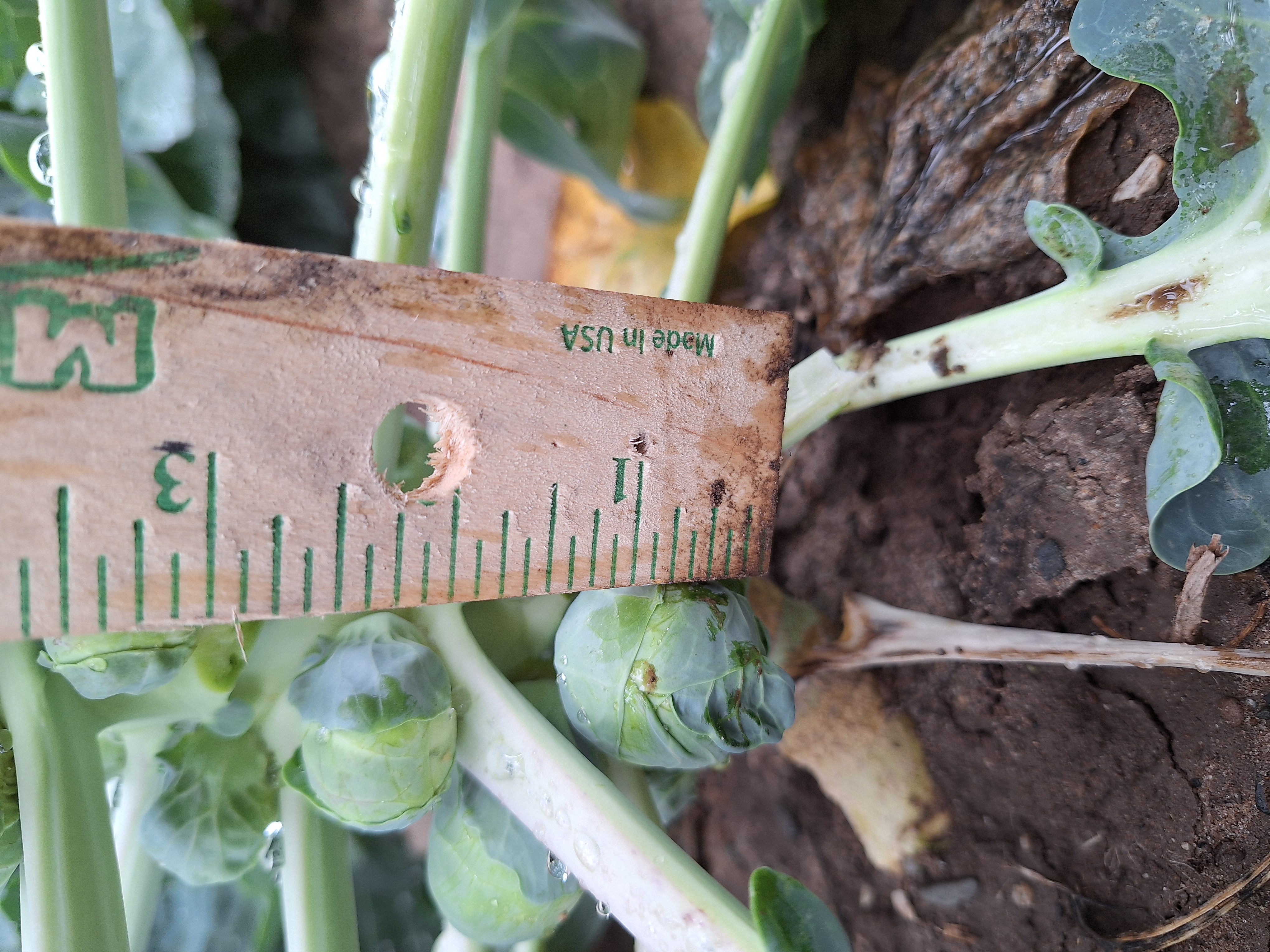
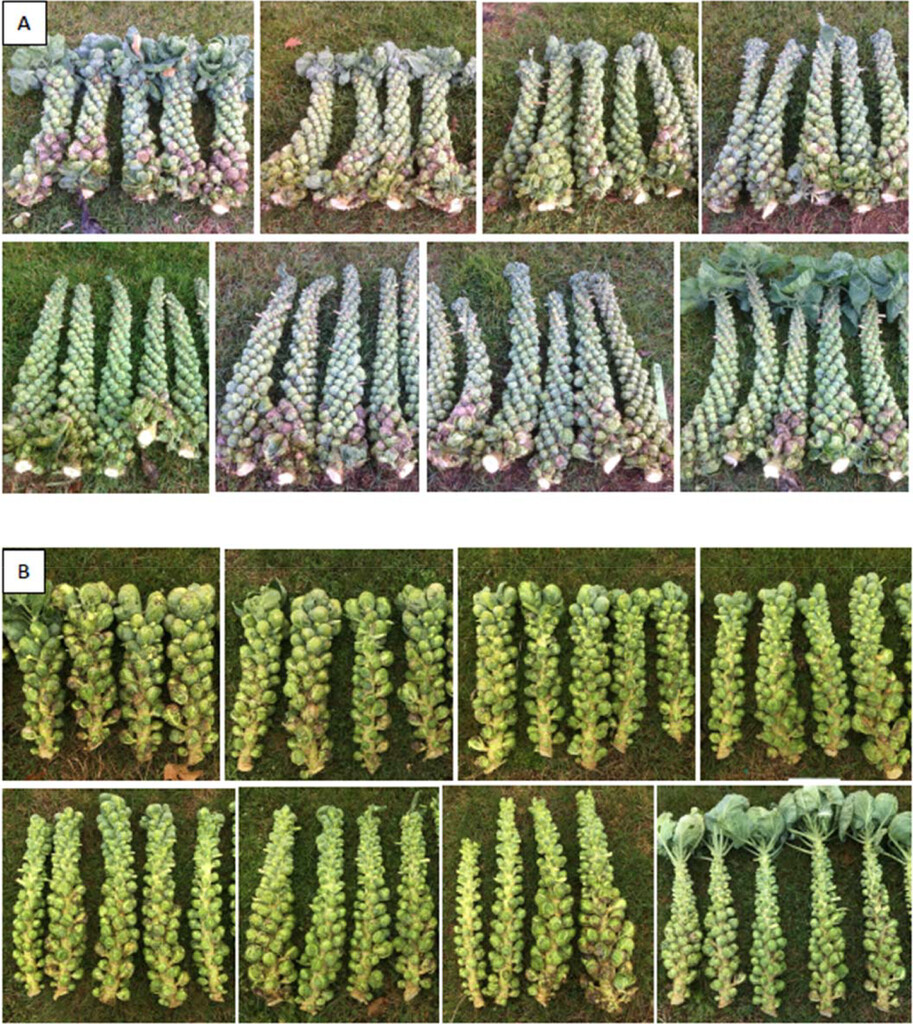
Carrots and celery
Eleven and twelve Disease Severity Values accumulated at two West Central carrot fields MSU extension is monitoring. At these locations, a fungicide application would have been indicated Monday if nothing had been applied since around August 9/10.
As onions go down, onion thrips can move into adjacent celery to cause damage. This can be most pronounced along edges of celery bordering the onions. There are a variety of good thrips materials that are labeled for celery; among these, spinetoram (Radiant) and cyantraniliprole (Exirel) may also provide caterpillar control (both have a 1-day PHI).
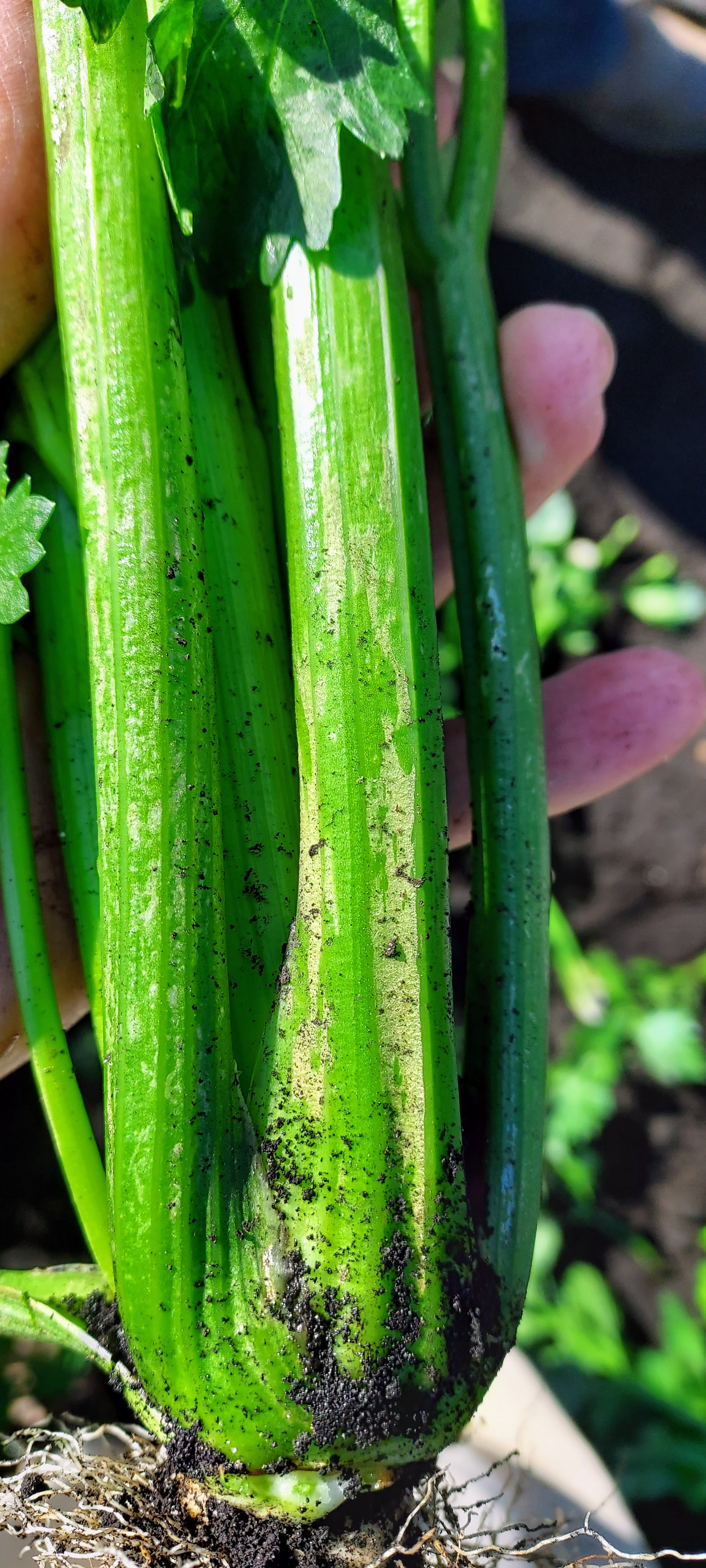
Cucurbits
All crops are being harvested, and pumpkins are sizing and showing color as powdery mildew settles in across the state. Plectosporium blight can also be found. When powdery mildew is not well controlled and the foliage begins to become blighted and dies prematurely, the pumpkin stems often become colonized by a variety of fungi that reduce the integrity of the stems which become weak and break, reducing its marketability. The best approach to stem health in pumpkins is to limit powdery mildew on the foliage as much as possible.
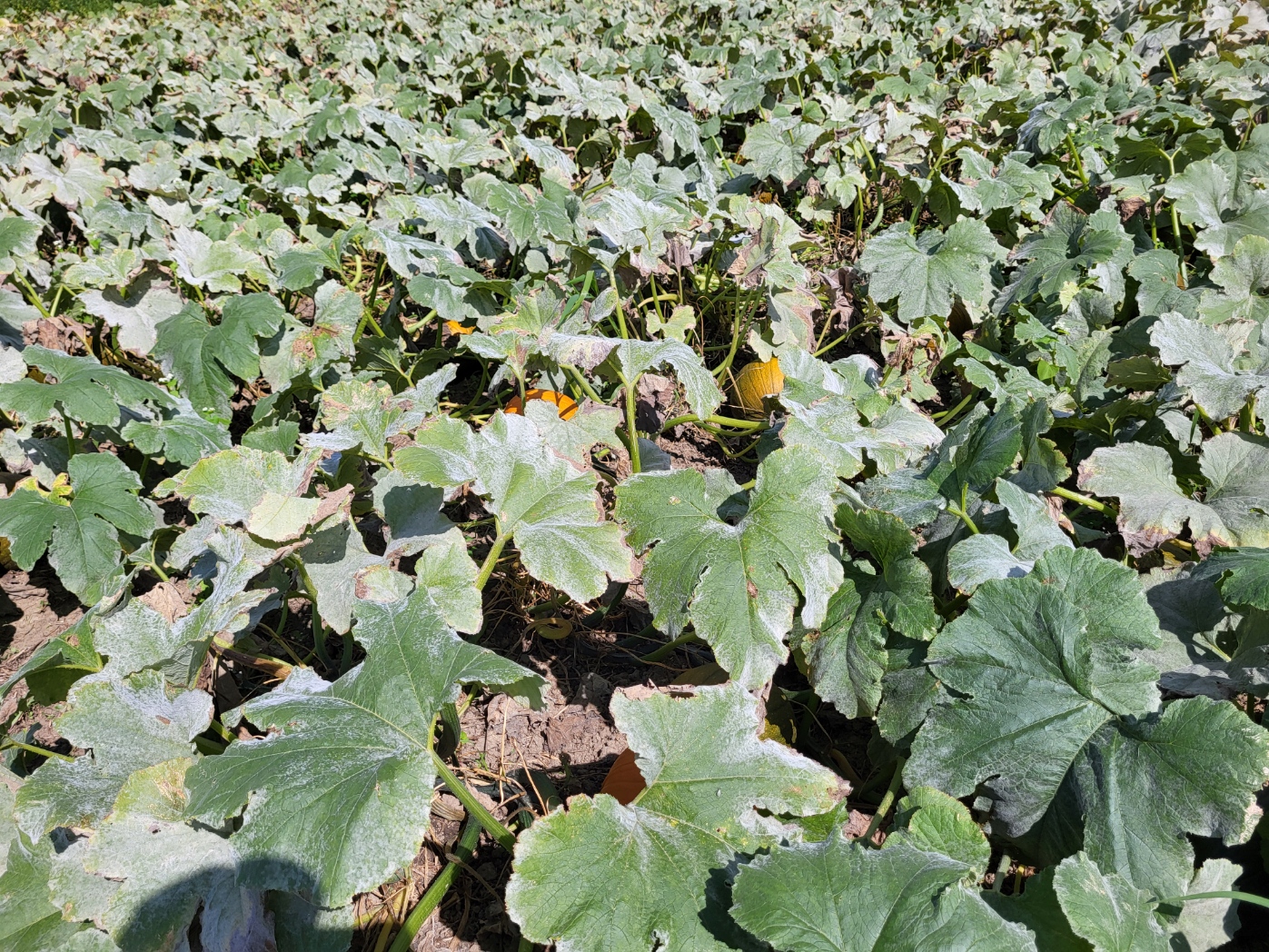
Stay vigilant against downy mildew and Phytophthora pathogens. Downy mildew on cucumber has been confirmed in 17 Michigan counties across all major production regions. MSU’s spore trapping and alert system has wrapped up for the season. Mary Hausbeck’s MSU vegetable pathology program has developed short fact sheets that are regularly updated to include the most effective and recommended fungicides that have been shown in years of field trials to be effective against these destructive pathogens.
Phytophthora fruit rot often reaches a peak in the late summer and early fall as winter squash and pumpkins mature. For pumpkins growing in Phytophthora-infested parcels, it may be helpful to harvest early and remove the fruit from the field and store in a dry location. Oftentimes, some disease will develop post-harvest as infection would’ve occurred while in the field but develops later on. There are no dips or treatments post-harvest that help with fruit rot. For zucchini and cucumbers, the recent cooler temperatures will have slowed down fruit development which increases the time of exposure to Phytophthora. Fungicide treatment is helpful but good coverage of the fruit is important. Applying the fungicides with adequate water is needed to penetrate the plant canopy to gain contact with the fruit. With harvesting, be mindful of the pre-harvest intervals. There are helpful factsheets for each cucurbit type located here. Growers who use these greatly appreciate them.
Cloudy, cool weather can favor female flower formation in zucchini at the expense of male flowers. The effect of cool temps can happen early in flower development, so there can be a time lag. All this means there can be a sporadic “shortage” of pollen, causing incomplete pollination of the more abundant female flowers. Female flowers with their developing fruit may then turn yellow and drop. These young fruit may also rot at the tip, getting fuzzy from secondary infection. If they do grow, incompletely pollinated fruit may be lumpy due to uneven fertilization of ovules (baby seeds). This issue will pass with better weather.
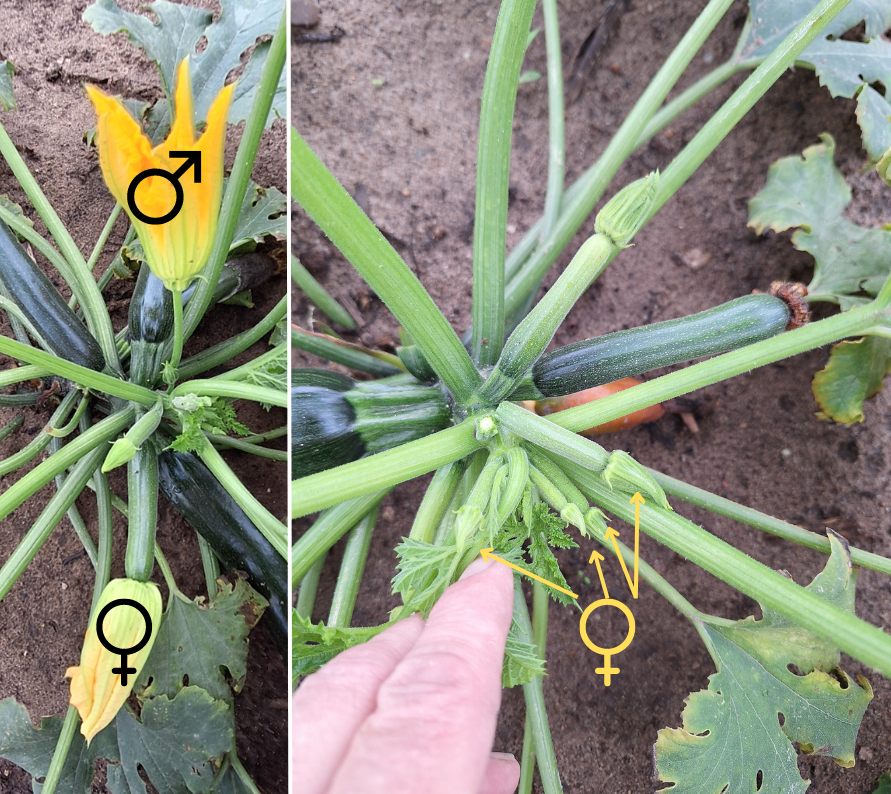
Fruiting vegetables
Eggplants are going to market now, as well as peppers, tomatoes, and okra. Tough love in the greenhouse means less heartbreak in the field from bacterial spot. Pseudomonas bacterial leaf spot has been reported on peppers with multi-race resistance to Xanthomonas. They are different pathogens, but can look similar.
Verticillium in eggplant and okra is a well-known but highly destructive pathogen in this crop. Verticillium wilt is caused by Verticillium albo-atrum and Verticillium dahliae. Verticillium wilt is considered the most destructive and serious disease of eggplant. While these fungi can infect other crops (e.g. tomato), eggplant and okra are especially susceptible. These soilborne fungi can result in 60 to 100% yield loss when symptoms appear early in the season. Even partial control of disease with fumigation increases yields three- to four-fold, making fumigation a standard control practice. Although 4-year rotations are helpful in reducing the risk for Verticillium wilt outbreaks, Verticillium spp. can persist in fields for 8 years as mycelium or micro-sclerotia. Significant progress has not been made in the development of resistant varieties. There are no known fungicides that are consistently effective against this pathogen so choosing a planting site that has not hosted Verticillium susceptible crops is key to limiting loss.
Onions and Garlic
Stemphylium leaf blight is evident where good disease control is lacking. Downy mildew has been noted and is not surprising given some of the wet conditions that have occurred during this growing season. Downy mildew occurs every 3 to 4 years in Michigan. It can be an especially devastating disease because it spreads rapidly and is not readily controlled. Downy mildew first infects older leaves, occurring as pale, elongated patches that may have a grayish-violet fuzzy growth appear early in the morning during moist periods. Lesions can be violet-purple in color; affected leaves become pale green, then yellow and can fold over and collapse. Infection can be systemic, with stored bulbs becoming soft, wrinkled, watery and amber in color. Asymptomatic bulbs can sprout prematurely and form light green foliage.
Peronospora destructor initiates infection during cool temperatures (<72 degrees Fahrenheit) and wet conditions. Multiple infection cycles can occur in a season, and consist of 9-16 days of latency, 1-2 days of sporulation, dispersal and infection. Spores are produced at night and dispersed during the day, where they can survive on host leaves for 1-3 days. Four infection cycles can almost completely destroy the foliage of an onion field. High daytime temperature and short or interrupted periods of humidity at night can prevent sporulation of the fungus. The fungus overwinters in volunteer onions, other host plants, onion cull piles, and in stored infected bulbs.
Preventative measures for Fusarium include high quality seed stock, crop rotation out of previous garlic and onion production areas. Fungicide options are limited and do not produce astounding effects against this pathogen.
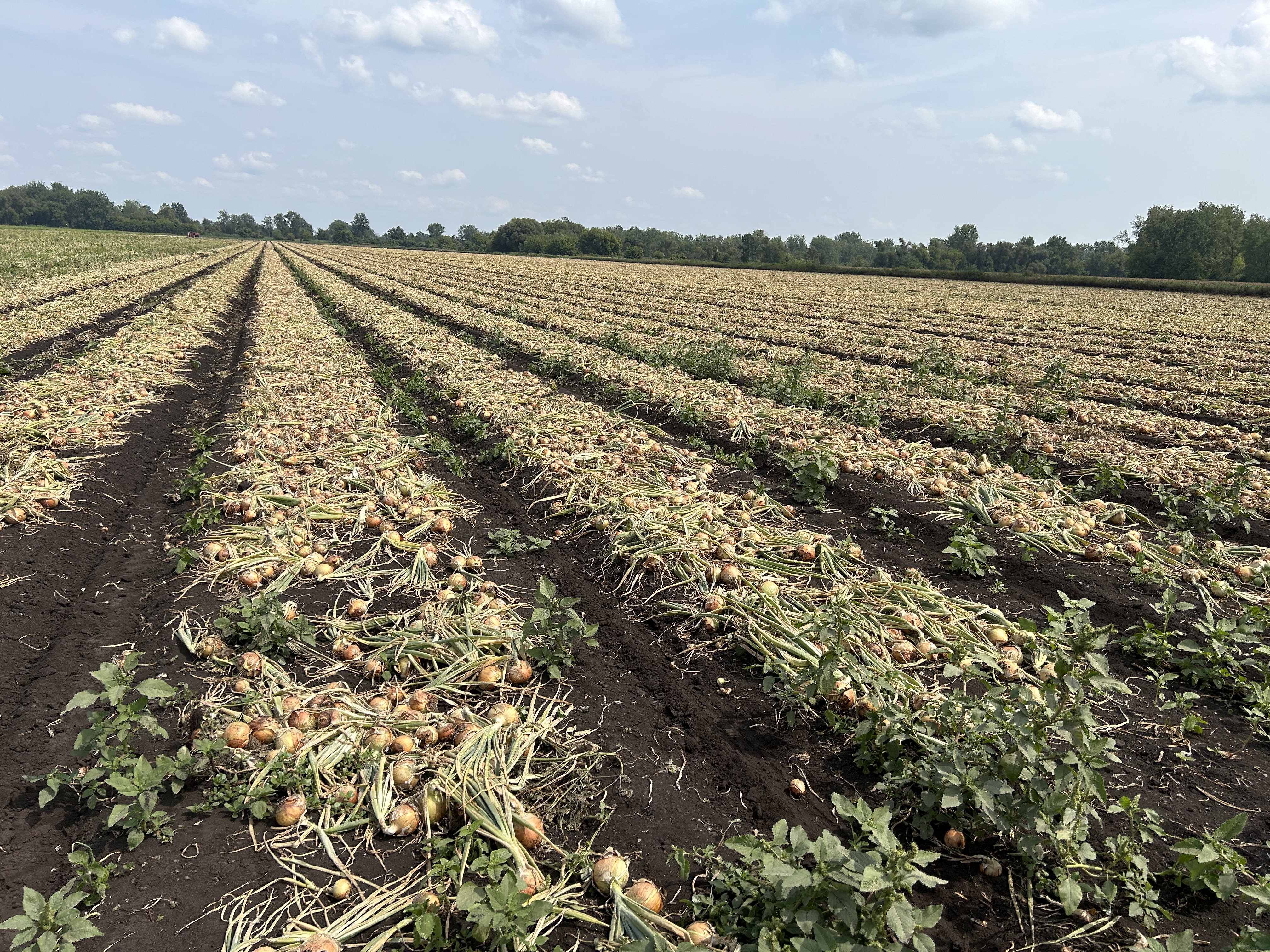
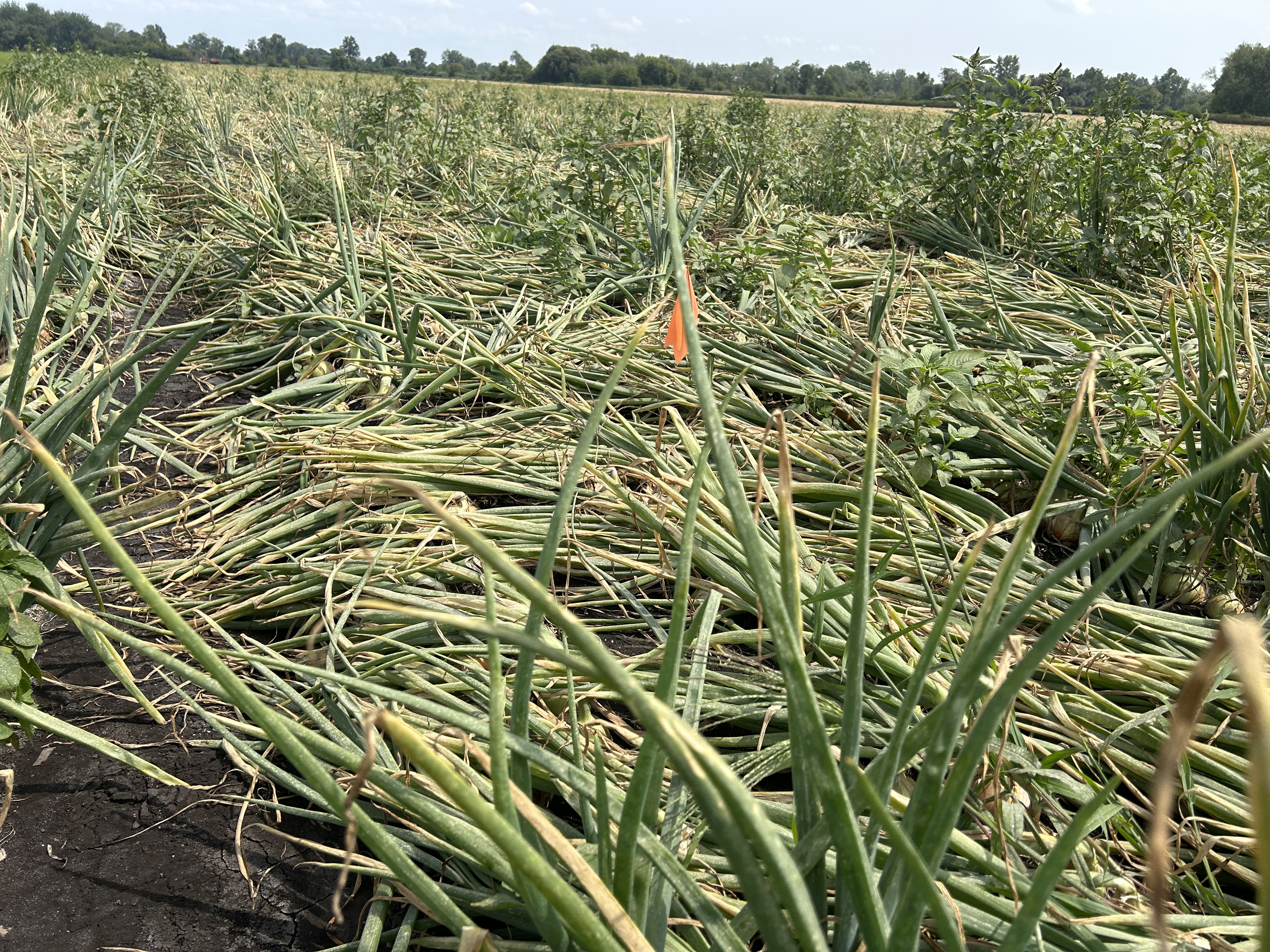
Sweet corn
Harvests continue, with good conditions in many parts of the state. Some farms are finishing up this week with back-to-school replacing the cookouts and road trips of summer, while others forge on.
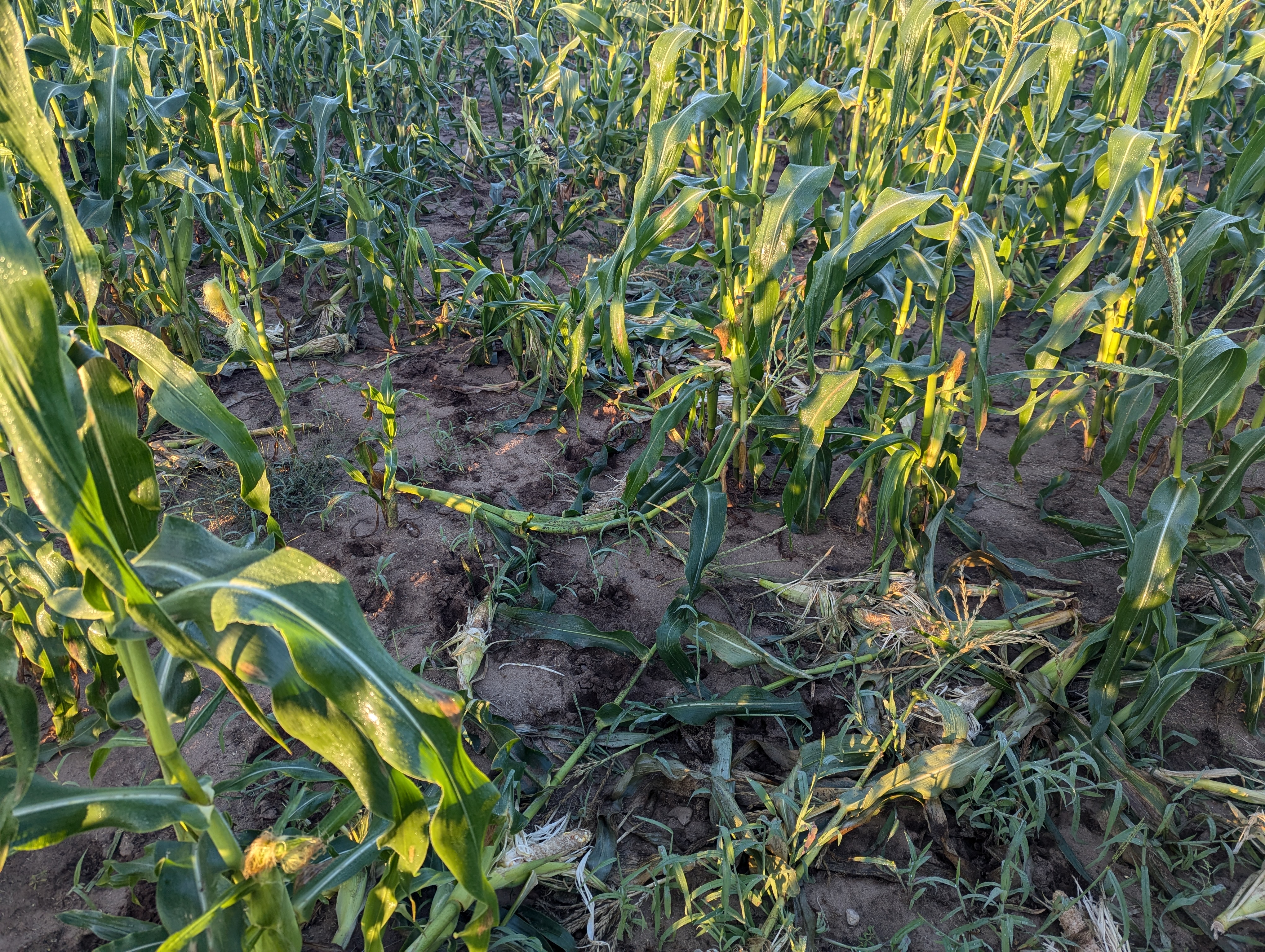
Corn leaf aphids have been reported in the Thumb region. Previous vegetable report from July 31 has information on this issue.
Corn earworm captures increased at some West Michigan locations over the weekend. To our south, trap catches greatly increased at some Indiana locations in Purdue’s trap network, while they remained low in Ohio State’s. The insect forecast website predicts a low risk of a corn earworm migration tomorrow, August 22, along the southern half of the Lake Michigan shore.
Products containing the active ingredients chlorantraniliprole or spinetoram may perform better than pyrethroids if and when captures increase. Tighter spray intervals may improve control when trap catches are high and/or weather is warm. Spraying can be discontinued once corn has 90% brown silks, as it’s the green silks that attract egglaying females.
|
Corn earworm captures. Total in trap for week1 (avg # per night2) |
||||||||
|
Week |
Monroe |
Washtenaw |
Oceana |
Ottawa |
Lapeer |
Bay |
Saginaw |
Berrien |
|
8/19 |
- |
0 (0) |
41 (13.7) |
44 (8.8) |
0 (0.0) |
3 (0.4) |
1 (0.1) |
18 (2.6) |
|
8/12 |
0 (0.0) |
0 (0.0) |
15 (1.4) |
8 (0.9) |
0 (0) |
0 (0.0) |
3 (0.4) |
5 (0.7) |
|
8/5 |
1 (0.1) |
0 (0.0) |
6 (0.9) |
28 (4.0) |
- |
1 (0.1) |
1 (0.1) |
4 (0.5) |
|
7/29 |
4 (0.5) |
0 (0.0) |
4 (0.7) |
13 (1.6) |
0 (0.0) |
0 (0.0) |
0 (0.0) |
3 (0.4) |
|
7/22 |
2 (0.4) |
0 (0.0) |
1 (0.1) |
0 (0.0) |
- |
1 (0.1) |
0 (0.0) |
4 (0.5) |
|
7/15 |
0 (0.0) |
1 (0.1) |
8 (1.1) |
15 (1.7) |
2 (0.3) |
0 (0.0) |
|
|
|
7/8 |
0 (0.0) |
2 (0.2) |
8 (1.1) |
14 (2.0) |
|
|
|
|
|
6/30 |
|
|
5 (1.0) |
30 (6.0) |
|
|
|
|
|
6/23 |
|
|
2 (1.0) |
|
|
|
|
|
|
1Total number collected since last trap check; 2The total number divided by the number of nights since the last trap check |
||||||||
Nutrient management survey
Soil nutrient deficiencies that limit crop yield are often foremost on farmer’s minds but nutrient excesses, especially phosphorus and nitrogen, seem to grab the headlines. Michigan State University Extension is asking farmers from all types of production systems to help identify practices they use by filling out a brief anonymous online survey describing soil conditions and approaches used for soil phosphorus and nitrogen management. Read more information and access the survey.
Produce food safety On-Farm Readiness Reviews
Schedule an On-Farm Readiness Review (OFRR) today for a 2-hour educational visit that takes place during the harvest season and is meant to be casual and low stress! Everything discussed during an OFRR is confidential and focused on ways you can reduce your own risks in relation to produce safety. There is no pressure to take our advice either, we are just here to support you in your produce safety efforts!
Events
- Aug. 22, 7-8 a.m., Field Crops Virtual Breakfast Series: Lime Recommendations for Field Crops
- Aug. 22, Summer Bus Tour and Annual Field Day at the Northwest Michigan Horticulture Research Center, Traverse City, MI
- Aug. 27, Drone Demonstration for Pest Management Meeting at the Northern Farm Market, Bruce Twp, MI
- Aug. 29, 7-8 a.m., Field Crops Virtual Breakfast Series: Maximizing Wheat Yield Potential
- Sept. 5, 7-8 a.m., Field Crops Virtual Breakfast Series: Drought-Proofing Agriculture with Drainage Water Recycling
- Sept. 5, 3-7 p.m., Organic Vegetable Production Workshop & Crop Walk, MSU Tollgate Center, Novi, MI
- Sept. 5, Long-Term Agroecosystems Research Field Day at the W. K. Kellogg Biological Station.
- Sept. 12, 7-8 a.m., Field Crops Virtual Breakfast Series: Grain Marketing
- Sept. 17, 6-8 p.m., Veggie Vibes at SWMREC
- Sept. 19, 7-8 a.m., Field Crops Virtual Breakfast Series: Late Season Weed Control
- Sept. 23, Field Day at the Trevor Nichols Research Center, Fennville, MI
This work is supported by the Crop Protection and Pest Management Program [grant no. 2021-70006-35450] from the USDA National Institute of Food and Agriculture. Any opinions, findings, conclusions, or recommendations expressed in this publication are those of the author(s) and do not necessarily reflect the view of the U.S. Department of Agriculture.



 Print
Print Email
Email

